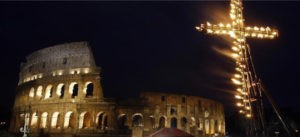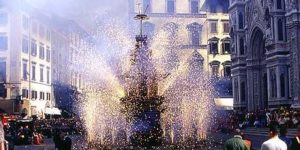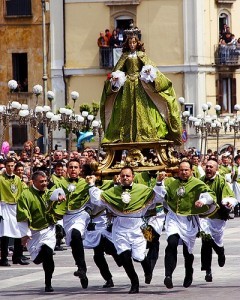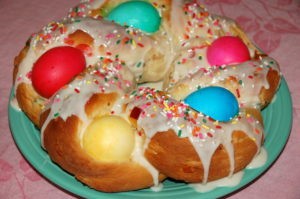
Easter or Pasqua is filled with many different rituals that are not familiar to Americans. First, there are no bunnies that lay eggs, and the traditions are very sacred throughout the country. Here’s a breakdown of the Easter weekend from all over the boot that highlights a variety of different rituals and traditions that are practiced by the North and the South.
On Good Friday, the Pope celebrates the Via Crucis or Stations of the Cross in Rome near the Colosseum. A huge cross with burning torches lights the sky as the stations of the cross are described in several languages. At the end, the Pope gives a blessing. Enna, in Sicily, has a large procession on Good Friday, with more than 2,000 friars dressed in ancient costumes walking through the streets of the city. Trapani, also in Sicily, is a good place to see processions, held several days during Holy Week. Their Good Friday procession, Misteri di Trapani, is 24 hours long. These processions are very dramatic. 
What’s believed to be the oldest Good Friday procession in Italy is in Chieti in the Abruzzo region. The procession with Selecchi’s Miserere played by 100 violins is very moving. Some towns, such as Montefalco and Gualdo Tadino in Umbria, hold live scenarios during the night of Good Friday or plays enacting the stations of the cross or Via Crucis and beautiful torch light processions are held in Umbria in hill towns such as Orvieto and Assisi. Read more about Good Friday and Easter in Umbria.

In Florence, Easter is celebrated with the Scoppio del Carro, explosion of the cart. A huge, decorated wagon is dragged through Florence by white oxen until it reaches Basilica di Santa Maria del Fiore in Florence’s historic center. Following mass, the Archbishop sends a dove-shaped rocket into the cart, igniting the fireworks held in the cart. This spectacular display is followed by a parade in medieval costumes.

Sulmona, in the Abruzzo region, celebrates Easter Sunday with La Madonna Che Scappa in Piazza. On Easter Sunday people dress in green and white, colors of peace, hope, and resurrection, and gather in the main piazza. The woman playing the Virgen Mary is dressed in black. As she moves to the fountain, doves are released and the woman is suddenly dressed in green. Music and feasting follow.
Since Easter is the end of the Lent season, food plays a big part in the celebrations. Traditional Easter foods in many places include lamb or goat, artichokes, and special Easter breads that vary from region to region. Pannetone and Colomba (dove shaped) breads are often given as gifts as are hollow chocolate eggs that usually come with a surprise inside.
